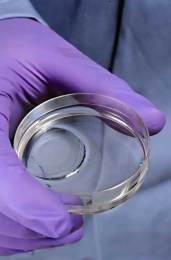Hydrogel shows potential for scar-free skin burn recovery
 Johns Hopkins researchers have developed a simple wound dressing that included a specially designed hydrogel – a water-based, three-dimensional framework of polymers – that promotes the formation of new blood vessels and skin, including hair follicles. It could lead to greatly improved healing for injured soldiers, home fire victims and other people with third-degree burns.
Johns Hopkins researchers have developed a simple wound dressing that included a specially designed hydrogel – a water-based, three-dimensional framework of polymers – that promotes the formation of new blood vessels and skin, including hair follicles. It could lead to greatly improved healing for injured soldiers, home fire victims and other people with third-degree burns.
“This treatment promoted the development of new blood vessels and the regeneration of complex layers of skin, including hair follicles and the glands that produce skin oil”, said Sharon Gerecht, an assistant professor of chemical and biomolecular engineering who was principal investigator on the study.
The hydrogel is mainly made of water with dissolved dextran—a polysaccharide (sugar molecule chains). Researchers aren’t sure how it actually operates, but they speculate that the hydrogel may be recruiting circulating bone marrow stem cells in the bloodstream in order to transform them into new skin and blood vessels.
“Our goal was to induce the growth of functional new blood vessels within the hydrogel to treat wounds and ischemic disease, which reduces blood flow to organs like the heart”, said Guoming Sun, Gerecht’s Maryland Stem Cell Research Postdoctoral Fellow who has been working with these hydrogels for the last three years in order to improve angiogenesis (growth of blood vessels). “These tests on burn injuries just proved its potential.”
After hydrogel dressing is applied, the tissue progresses through the various stages of wound repair. The researchers found out that the gel needs 21 days to become harmlessly absorbed, and the tissue continues to return to the appearance of normal skin. It was tested on mice tissue and achieved complete skin regeneration, which never happens in typical burn wound treatment.
“We were surprised to see such complete regeneration in the absence of any added biological signals”, said Gerecht. “Inflammatory cells are able to easily penetrate and degrade the hydrogel, enabling blood vessels to fill in and support wound healing and the growth of new tissue.”
The hydrogel developed by researchers at Johns Hopkins’ Whiting School of Engineering, working with clinicians at the Johns Hopkins Bayview Medical Center Burn Center and the Department of Pathology at the university’s School of Medicine, contains no drugs or biological components, and it could form the basis of an inexpensive burn wound treatment that works better compared to other currently available clinical therapies, and it could be easily manufactured on a large scale.
If the treatment becomes allowed for use on human patients, the new hydrogel could have enormous potential to restore normal skin structures for other injuries such as skin ulcers, aside burn recovery.
For more information, you can read the article published in the Proceedings of the National Academy of Sciences named: “Dextran hydrogel scaffolds enhance angiogenic responses and promote complete skin regeneration during burn wound healing”.










where i can get this product in pune india